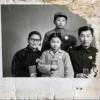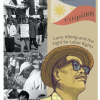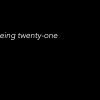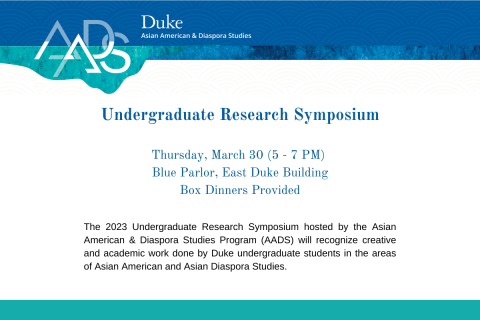Undergraduate Research Symposium Spring 2023
The 2023 Undergraduate Research Symposium hosted by the Asian American & Diaspora Studies Program (AADS) will recognize current or past creative and academic work done by Duke undergraduate students in the areas of Asian American and Asian Diaspora Studies. Students were invited to submit an application to be selected for inclusion in the symposium.
The event will take place on Thursday, March 30 from 5-7 PM at the Blue Parlor, East Duke Building. Box dinners will be provided for those in attendance. If you have any questions, please contact AADS at dukeaasp@duke.edu.
Speaker(s)

The Filipino American Experience: Martial Law and the American Dream by Kyle Coaker
Undergraduate Student
Duke UniversityBio: Hey everyone! My name is Kyle Coaker and I am a sophomore here at Duke studying Chemistry with minors in Biology and Spanish Studies. I am a Filipino-American with roots from the Bay Area in California, and I love to engage in my Filipino culture by eating one of my favorite dishes, pork tocino with garlic fried rice and eggs. I also love to play my trombone at church during Simbang Gabi, a nine-day series of Masses attended by Filipino Catholics in anticipation for Christmas.
Project description: My project explores Filipino Americans’ experience of martial law in the Philippines and their subsequent migration to the United States through the oral histories of my Nanay (grandmother) and my mother. More specifically, my research delves into my mother's experience as a "martial law baby" in the Philippines, examining how her family survived during the economic hardships and military restrictions of that time. Additionally, it explores how my mother's pursuit of becoming a physical therapist and the Philippines' role in supplying medical professionals to the United States contributed to her immigration to the San Francisco Bay Area, where she maintained her Filipino American identity as part of a multiracial family.
Towards Free Thought: My Father's Journey by Annette Lu
Undergraduate Student
Duke UniversityProject description: It is a graphic novel which I created after interviewing my dad for my Writing 101: Asian American Narratives final project. It is in black and white and red, and is 9 pages total including the cover page. It describes my father’s life, being born during the Cultural Revolution and growing up under Mao’s strict reign. He then experiences the change in China after Mao’s death and studies to leave China in pursuit of education. He was in Tiananmen Square during the protests, where one of his coworkers was killed. He finally left China to find opportunity and education. Overall, it represents the immigration of Chinese Americans and their experience through a personal lens.

Chinese American Surveillance by Matthew Huang and Andrew Liu
Undergraduate Student(s)
Duke UniversityChinese American Surveillance Presentation | Website
Bio: Andrew is a senior studying biomedical engineering with the hopes to apply those engineering principles to medical care as a future physician. Shaped by previous experience in high school debate discussing American surveillance and Orientalism, he hopes to also pursue a diverse set of research interests which integrates Asian American community dynamics as they interface with institutions such as policing and healthcare.
Bio: Matthew Huang is a senior studying biology at Duke University. He also hopes to one day attend medical school, and is interested in serving as a flight surgeon for the Navy or Air Force. Currently, he is working on an oral history project highlighting the unique experiences of military-affiliated Asian Americans at Duke.
Project description: Making up 24% of Asian Americans within the United States, Chinese Americans of both past and present have had a complicated relationship with their American identity. Similar to other Asian American identities, many Chinese Americans from the late 1900s to today have been tolerated for their economic value as an educated class of immigrant labor. Yet, their perceived American status has persistently been jeopardized by the confounding fears of a rising communist China. Despite their individual disdain towards Communism or their patriotic attitudes towards America, their loyalty continues to be doubted. This complex dynamic of tolerance and fear disrupts the lives of Chinese Americans. It is our hope that through the stories we convey about three different Chinese Americans, we can help to both humanize Chinese Americans and expose some of the inconsistencies that undergird the US’s criminal justice apparatus.

Chinese American: Guang Guo Oral History by Aida Guo
Undergraduate Student
Duke UniversityBio: My name is Aida Guo and I am a first-year from unceded Tuscarora Land (Cary, NC) studying International Comparative Studies. In the fall semester, I took Writing 101: Asian American Narratives with Dr. Susan Thananopavarn and was able to create a zine titled, "爸爸, 爸, dad" about Guang Guo's (my father) upbringing during the cultural revolution and his immigration to the U.S. afterwards. The zine is composed of a series of letters where I write to him in different parts of his life. I also incorporate real and drawn images of various parts of his life.
Project description: Documented my father, Guang Guo's, life from his childhood during the cultural revolution until immigrating to the United States to study at university. After multiple interviews and research, I created a zine organized as a few letters from myself to him throughout various points of his life. I incorporated personal photographs, self-drawn digital artwork, and internet-sourced images. I also wrote an accompanying artist statement to explain and give context to what is happening within the zine. This was my Writing 101: Asian American Narratives final project.

Forgotten Filipinos Zine: Larry Itliong and the Fight for Labor Rights by Angela Claveria
Undergraduate Student
Duke UniversityForgotten Filipinos Zine: Larry Itliong and the Fight for Labor Rights Presentation | Artist Statement
Bio: My name is Angela Claveria, and I am a freshman studying biomedical engineering on the pre-medical track. During my fall semester, I was given the opportunity to create a project that highlighted the story of any Asian-American figure and their place in history. With that freedom, I knew I wanted to research Filipino-Americans and how they played a role in major movements in the US. This was a result of the underrepresentation of Filipino-Americans that I noticed growing up; when I think back to my past education, I cannot recall a time a Filipino-American was noted for their accomplishments. As I was researching who to do my project on, I came across Larry Itliong. His impact on the labor movement in the United States was profound, yet he as a person was left in the shadows. I decided to tell his story through a zine. This medium is popular for its DIY techniques of cutting and pasting images/texts from different sources to create one complete collage. To me, this medium is symbolic to Itliong’s monumental grape strike at Delano; he took the pieces of underrepresented voices and joined them together into one powerful force. I hope in the future to expand on this "Forgotten Filipinos" zine series and further explore these figures and their accomplishments that have been lost in history.
Project description: Filipino activist and laborer Larry Itliong was involved in labor strikes along the West Coast and Alaska during the 1930s up until the 1970s, forming and leading various labor unions. He is, however, most notable for his leadership in the 1965 Delano Grape Strike; this five-year strike would lead to the passing of the Agricultural Labor Relations Act of 1975. Not only did an Asian-American make a profound impact on a movement that had a history of oppressing his race, but he did so by uniting two marginalized groups (Filipino and Mexican farmworkers) through the same shared goal, a move that would have shocked the American unions during the early labor movement. My project uses oral histories to tell Itliong’s story through the format of a zine; this medium is popular for its DIY techniques of cutting and pasting images/texts from different sources to create one complete collage. To me, this medium is symbolic to Itliong’s monumental grape strike at Delano; he took the pieces of underrepresented voices and joined them together into one powerful force – one that was impossible to ignore. Larry Itliong’s leadership in all his strikes shows his leadership and ability to fight for the common people even when he faced disadvantages because of his race and education level.

From Laos to America: The Legacy of Chue Yang and His Family by Thulsy Krishnan
Undergraduate Student
Duke UniversityBio: My name is Thulsy Krishnan, and I am a freshman from Atlanta, Georgia. In my oral history project, I tell the story of my aunt’s Hmong American family. My aunt’s father, Chue Yang, was a captain of the CIA’s “Secret Army” of Hmong soldiers who fought as allies of the United States during the Vietnam War. My project covers Chue Yang’s experience fighting in the Vietnam War, his family’s escape from Laos to America, and their experience as Hmong refugees in the United States.
Project description: An ethnic minority in Laos, the Hmong fought as allies of the United States in the CIA’s “Secret Army” during the Vietnam War. My aunt’s father, Chue Yang, was a captain of this “Secret Army.” My aunt was a baby when her family fled Laos for America, four years after the U.S. withdrew from Vietnam. In my oral history project, I tell the story of Chue Yang and his family. I interviewed my aunt about her family’s experience, and I also researched historical information on the Hmong experience during and after the Vietnam War. The story of my aunt’s family reveals the far-reaching effects of the U.S. military intervention in Laos during the “Secret War.” From the extensive persecution and displacement they suffered after the war, to the language barriers, poverty, and racism they faced in America, Hmong refugees like my aunt’s family endured many challenges. Yet, my aunt’s story shows how Hmong refugees remained resilient as they rebuilt their lives in America. As a family- and clan-oriented culture, they created new Hmong communities and relied on their fellow Hmong for comfort and support. While my aunt’s story reveals how many Hmong Americans have worked hard to preserve their Hmong culture, it also shows how they have successfully navigated American society and have even intermarried with other groups, which is how my aunt became a part of my family.

On Being Twenty-One by Preetha Ramachandran
Undergraduate Student
Duke UniversityBio: Preetha is senior studying Cultural Anthropology and Neuroscience. The creative project she will be presenting is an audio documentary about the motivations for her mom's move from India to the United States. The story is framed by age; her mom was twenty-one when she made this migration and Preetha is twenty-one, currently. Putting past and present in conversation, this project is interested in the complex motivations that underscore diaspora stories.
Project description: My mom was twenty-one when she got married, moved continents, and enrolled herself in graduate school in the United States. This is why I, an introverted, far from marriage, largely anxious senior in college, was scared to turn twenty-one; my mom’s maturity at twenty-one feels foreign and unattainable to me. Here, I confront this. Using audio documentary as my medium, I tell a South Asian Diaspora story and put history and present in conversation; I call my mom and ask her about her twenty-one-year-old self and pose the question…are we so different after all?

The Real Value of Education by Jennifer Xu
Undergraduate Student
Duke UniversityBio: Hi, my name is Jennifer Xu, and I’m a sophomore on the pre-med track with the hopes of one day becoming a pediatrician. As a Chinese-American woman, I’ve always been interested in further examining the intersection of my identities, and Dr. T’s “Asian American Narratives” Writing 101 class was the perfect opportunity to do so. For our final paper, we were tasked with exploring an aspect of Asian American history through the telling of a single person’s story. Most naturally, I thought to interview my mother about growing up in China and immigrating to the United States. Through only two hours of conversation, I learned more about my mother than I ever have in my life. I learned about how the Great Chinese Famine devastated her working-class family, how profound an impact the Tiananmen Square Protests had on her life, and, most importantly, how education was the sole reason she was able to escape poverty and repression.
Project description: This project aims to refute the stereotype of the Tiger Mother by unveiling the complex historical background that shaped a generation of these so-called “Tiger Parents’” views of education.
Video Essay: Chinese Music Usage in Video Games by Anna Fan
Undergraduate Student
Duke UniversityProject description: Video Games and online gaming as a whole have been growing increasingly popular in modern times. With new innovative technology, virtual games have been able to spread from computers to phones and into 3-d virtual reality. Now billions of people play some virtual games, and the virtual game audience encapsulates a diverse group of players. As the textbook, Cambridge Companion to Video Game Music describes, “ Games present us with virtual spaces and universes, and ask us to interact with them. These worlds are virtual because they cannot be sensed directly like our everyday reality, but instead, we perceive them through the channels of audio, video, and, sometimes, touch, that the game apparatus provides.“ In other words, virtual games utilize various tools to immerse the player in their world, and this video essay focuses mainly on one of these tools, music, specifically Chinese music, and the significance of its usage in games. The guiding questions for this project are how Chinese music is used within video games, what it represents and expresses to the players, and what are the potential consequences and impacts of these representations. Additionally, some music analysis guidelines are where and when does it take place in the game? What genre is it? what Instruments are being used and how? How is it used in the game? And what effect or reaction does it give the player? This project will use music examples from mainly three games Street Fighter, Journey, and Genshin Impact for an overview of how Chinese music has changed over time and to analyze the player-game relationship.
Writing to Heal: An Examination of Intergenerational Trauma in Vietnamese American Literature by Katie Tsai
Undergraduate Student
Duke UniversityProject description: Until the end of the 20th century, most cinematic and literary depictions of Vietnamese people were through the lens of the Vietnam War and, as such, focused primarily on the experiences of American soldiers and veterans. Increasingly, the Vietnamese have been finding alternative representation in the works of contemporary Vietnamese American writers; these works, moreover, offer different accounts of—and perspectives on—the Vietnam War and subsequent Vietnamese American experiences. One such experience is that of intergenerational trauma. During and after the Vietnam War, many Vietnamese refugees not only experienced trauma directly but also passed on trauma to their descendants. Vietnamese American writers, particularly those of the 1.5 generation, have used literature to talk about, process, and heal from individual and intergenerational trauma. In the many Vietnamese texts I will discuss, such as Lan Cao’s Monkey Bridge, mai c. doan’s water/tongue, and Thi Bui’s The Best We Could Do, narrators use writing to expel trauma from the body and to prevent the transmission of trauma to future generations.
Memory in the Machine: Theorizing Transcorporeal Practices of Diasporic Memory-Making through Conversations with GPT-3 by Miriam Shams-Rainey
Undergraduate Student
Duke UniversityProject description: In this research, originally presented as a final project for AADS 201, I experimented with transcorporeal diasporic memory-making and narrative construction through a simulated “conversation” with a language model called GPT-3. Exploring the role of the non-human in the social (or perhaps pseudo-social in this case) practice of memory-making, I drew upon Huan He’s connections between the model minority as a racial interface and the computer interface as palatable abstractions of the machinations underneath (racial capitalism, white supremacy, circuitry and software developed by and for military use, etc.) and theories of memory emerging from critical refugee studies (Nguyen) and studies of military imperialism’s afterlives in East and Southeast Asia (Fujitani et al.). Using a GPT-3 model given basic context about my family’s diasporic and migration history, I used this artificial intelligence to both simulate social memory-making practices and speculate about the aspects of my family’s history that my mother and other family members have been reticent to share, theorizing about “truth” in shared and socially-constructed narratives of migration and war. Finally, mindful of the ways artificial intelligence often represents the biases of its creators and training data, I analyzed GPT-3’s outputs in this conversation to examine how this non-human entity orients itself vis-à-vis the “Orient,” placing these results in conversation with ongoing computer science research on the ethics of artificial intelligence and large language models.
New Disease Same Prejudice by Emily Wu
Undergraduate Student
Duke UniversityProject description: In 19th century San Francisco, public journals, politicians, and health professionals exaggerated the characterization of Chinatown and its inhabitants as alien and dirty. With this notion becoming a scientific truth, a genetic predisposition, public opinion quickly became distress as Chinese Americans were viewed as dangerous. Now in the 21st century, the common belief of Chinatown as disease-ridden and inhumane is once again amplified with the radicalization of ideas during the Covid-19 pandemic. In this project, I examined this cyclic nature and continuity of racial presumptions against Chinese Americans. Concentrating on the story of Kenneth Chin, a Chinese American YouTuber, I explored the racism and micro-aggression present in and out of New York City’s Chinatowns even before the pandemic was truly declared a national crisis. Through Chin’s eyes, I also witnessed the mass shutdown of his favorite Chinatown restaurants unable to be attributed simply to the pandemic as Little Italy just across the street was booming with business. I chose to present my research into Chin’s story and anti-Chinese prejudice as a graphic novel with images from Chin’s YouTube videos to emphasize the relevance and realness of his experience. Certain design elements such as wavy speech text and color choice add to the vivid visualization of each event Chin encountered.

Blue Parlor, East Duke Building
Sponsor(s)
Duke Asian American & Diaspora Studies
